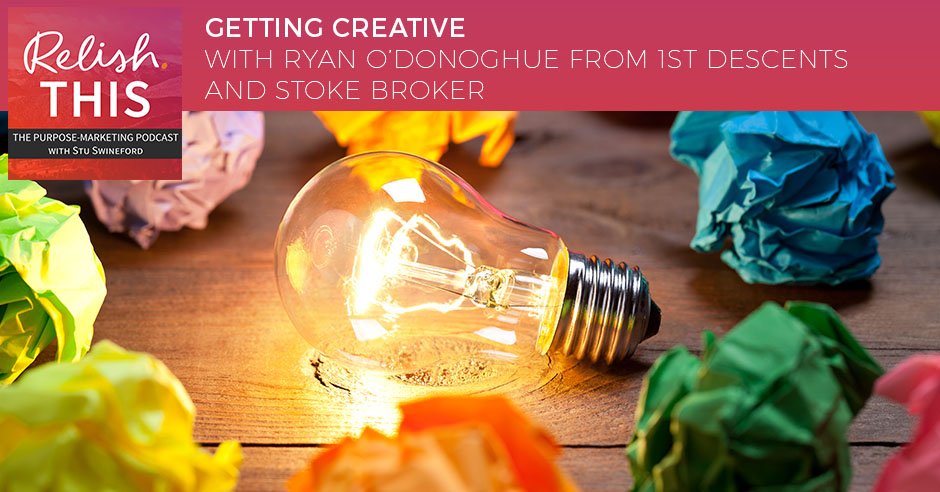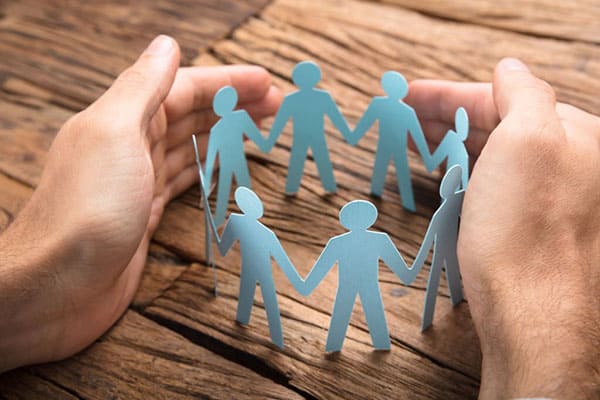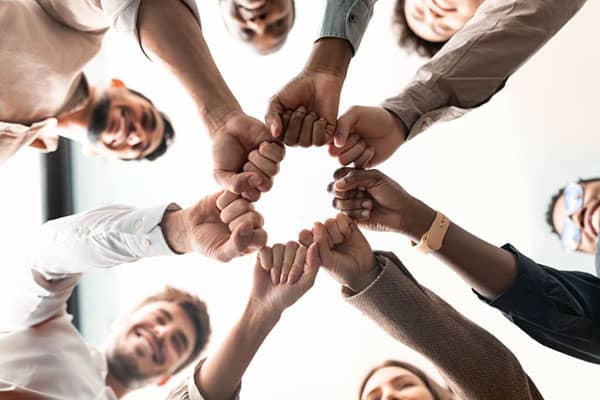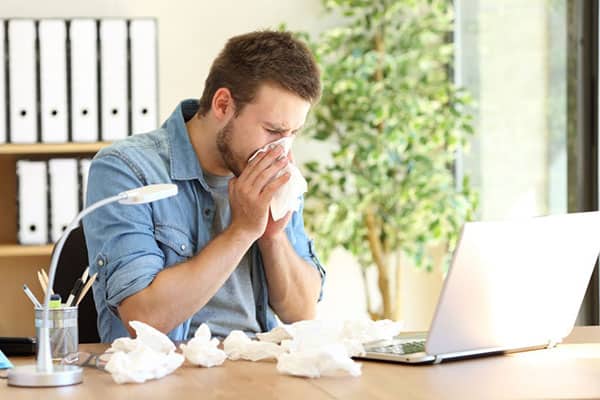
Today’s guest today is Ryan O’Donoghue, CEO of both the nonprofit First Descents and the for-profit company Stoke Broker.
First Descents provides life-changing outdoor adventures for young adults impacted by cancer and other serious health conditions. Stoke Broker takes the wealth of expertise First Descents has developed over the past 20 years and applies it outside of the nonprofit space. Profits from Stokebroker, an adventure travel company, are then funneled back into FD to further fuel their mission.
It’s an interesting model that recognizes how work in the nonprofit space can be applied to create new revenue streams in the for-profit sector—revenue that then directly benefits the nonprofit that inspired it.
You’re really going to enjoy this conversation.
Links:
First Descents: https://firstdescents.org
Stoke Broker: https://stokebroker.com
Action Ask:
Share something that you are passionate about.
—
Listen to the podcast here
Getting Creative With Ryan O’Donoghue From 1st Descents And Stoke Broker
My guest is Ryan O’Donoghue. He is the CEO of First Descents and Stoke Broker. They do some amazing stuff in the outdoor space, trying to help survivors of life-threatening illnesses get these passion, drive, and experiences that can only be found outdoors. They have been around for many years and have a great established organization.
Stoke Broker is their new for-profit organization that funds or fuels some of the things that First Descents do. Our conversation was interesting and fun. The two big takeaways for me were believing in the passion of the mission and tapping into that passion as you are developing your nonprofit, and then looking for ways to partner with other nonprofits where instead of creating duplication in the space, figuring out how you can create collaboration. Collaboration is part of the First Descents’ ethos, and you’ll read that come out. I had a great time. I hope you enjoy it. Here we go.
—
Ryan O’Donoghue. Thanks for being on the show.
Thanks for having me, Stu.
It’s my pleasure. It’s cool to have you on. You are doing some great work there at First Descents. We’d love to know all about it.
I appreciate that. We are incredibly passionate about our work and excited to have a platform to share with any new audiences out there who are new to our work.
Tell us a little bit about what you guys are up to. It’s a new year. How are things going there for you guys?
Things are good. Before we get started, can I ask you a question?
Absolutely.
I went back to the show that inspired the start of your show. I have a question that pertains to that. Am I a part of your top ten nonprofit leaders you wanted to interview?
Healthcare workers are really incredible at taking care of others, but self-care can sometimes land on the back burner for them.
You are. I have a laundry list of people that I’d like to interview. It ranges from people who are getting started. I have talked to a lot of people who are starting out. There are some people who are doing a great job of crushing it in this nonprofit space, and I would put you among that elite group. You guys have been doing this for quite some time. It’s exciting to have you on the show to talk about.
It’s an incredible honor. I was joking there, but I have read a handful of your blogs. I love them. You have some incredible guests on there. There are lots of learnings, and I like to continue to learn from other leaders doing great work. I appreciate everything you are doing with the show. In terms of First Descents, we are excited to enter a new year. We are facing a lot of similar challenges to what we faced in 2020.
The one big differentiator is that we are entering a year knowing what our obstacles are and many of the challenges we are up against. It almost feels like entering the second half of a game where you are a little more knowledgeable about your opponent and your strategy, but you still have to get back on the field, and there is still a lot of hard work to be done ahead of us.
This 2021, we are excited to get back to more core programming, which is outdoor adventure programming. Historically, for young adults impacted by cancer, we introduced other serious health conditions in past years, including multiple sclerosis. In the time of COVID, we also weren’t able to serve those populations and pivoted to serve healthcare workers.
We’ll continue serving healthcare workers on the front lines of COVID and expect that in the early part of the year, our programs will be focused on that population for a number of reasons. They are at the top of the list when it comes to vaccinations. They also have done a great job. They need the support, but they also know how to keep themselves safe in an environment where COVID is prevalent.
We have done a lot of work to adjust our program control measures to make sure that we can host safe and healthy programs for everybody. We’ll host anywhere between 30 and 40 multi-day programs throughout the country. We’ll focus on a couple of key regions with the highest demand based on the inquiries we have received through our process.
I’m excited. There will be climbing programs, paddling programs, and hiking. We have a great yoga and mindfulness component that we weave into these programs as well, particularly for the Hero Recharge programs. One of the things that we have learned in conversations with our friends within the healthcare community is that oftentimes healthcare workers are incredible at taking care of others, but self-care can sometimes land on the back burner for them. We are leaning in and supporting those folks who are doing so much to support the broader community during this unprecedented time.
I remember when you guys announced that you were pivoting a little bit to include healthcare workers as primary recipients or beneficiaries of your services. I thought that was such a wonderful idea. As you’ve illustrated, it’s well thought through as well based upon safety protocols and everything else. I have a few friends who are in healthcare. One is a respiratory therapist. He’s right on the front lines of all of this stuff. Those guys have all been hit hard by the psychological as well as the physical component of trying to take care of people 24/7.

The biggest asset of anybody reading is if you know people who can benefit from our programs, please send them our way. That does include young adults impacted by cancer, primarily people in their 20s and 30s similar to multiple sclerosis, and then this new healthcare worker population. Your friend would be a great candidate. I would love to get them out there. We have had a number of respiratory therapists out at our programs, and that is a group that’s hard at work throughout this whole pandemic.
He used to be a river guide as well. I’m sure he would have a blast as part of that program.
It’s even better because, in the long run, we always need great medical volunteers in our programs. Anytime we can get people out to a program, either as a participant or a medical volunteers, that’s always a great way to plug in.
I will mention it to him for sure. What’s been one of the biggest challenges that you have been facing? Aside from the safety protocol pieces, are there any other components in terms of getting in touch with people? Is it an education piece at this point for you that’s the biggest challenge?
There were a number of challenges. One of them is trying to gauge people’s level of comfort with engaging in experiences like this. That’s one. Another one for us is revamping our program design. We have partnered with lodging partners and outfitters throughout the country. Oftentimes we bunk up in a room where there are two beds in that room. That’s a no-go in the current environment. We have had to move into a model where we have single occupancy rooms.
We are doing all the other program control measures that have been largely informed by an infectious disease specialist who we contracted in to help refresh our communicable disease plan with a special focus on COVID. For us, a lot of it is finding new partners to work with who have accommodations that can support single occupancy rooms for our participants and our staff, also in areas where there’s close proximity to the great activities that we love to offer, which is rock climbing, ice climbing, whitewater kayaking, surfing, and any outdoor adventure sport you can imagine at this point. We have been around for many years and began primarily with week-long whitewater kayaking programs.
The organization has evolved quite a bit over the years. Now it’s anything that falls into the outdoor adventure category, mountain biking, hiking, mountaineering. You name it. It depends on what those programs look like and what areas. For now, we have had to simplify and streamline our approach. The approach going into 2021 is taking a simplified approach to how we think about program delivery and then hopefully building towards a bigger ramp-up in 2021 and beyond. People are going to be chomping at the bits to get outside and reconnect with their peers.
I was talking with someone on a hike about tourism. It has been incredibly impacted by all of this and whether or not it will be easier to travel here coming out or harder as people are so excited to get back out and live that lifestyle that they have been dying to get in back to. It’s going to be interesting to see how things roll out, but it’s cool that you have identified some of the big challenges and are looking toward those opportunities to solve those problems.
We introduce incredible adventure experiences that empower people to really push beyond some perceived limitations that they’re feeling at any given time.
Add us the list of many businesses trying to make the adjustments they need to remain relevant. For us, what’s most important is to be of use. That was one of the things that we found with our team early on. I got to admit there was a moment there where it felt pretty paralyzing thinking about having to cancel hundreds of programs throughout the country and not knowing what we could do.
One of the things we did early on was we were able to pivot our staff and focus on some of the frontline COVID relief work in the local area, supporting organizations like the Action Center and Denver Delivery Network, amongst others. Soon after, in partnership with a lot of the hospitals and providers that we work with throughout the country who are supportive of referring patients to become participants of our program in any typical year, we were in conversation with them, hearing how much they are navigating with this.
We felt, “This might be an opportunity to be of use and to be of service.” The team rallied behind that. That kept us motivated throughout the year because, at first, I’m sure many people were experiencing this. There’s some shared universal empathy here. As a leader, I was a little bit paralyzed there for a little bit, trying to figure out how we move forward.
Is that typically how beneficiaries get introduced to your program through their care facilities?
The two top sources of a referral for us are word of mouth, and now it’s also becoming learning about us online through social media. Otherwise, it is through a campaign that we launched titled Prescribe Adventure. We have over 400 hospitals and medical centers throughout the US, with nearly 800 providers who are signed on to be advocates of that program and sharing information about First Descents with their patients at a time that makes the most sense within their healing. It is an incredible source of referrals from our medical community.
I wasn’t quite sure what activities you guys were employing to get in front of beneficiaries other than the obvious general marketing stuff and online activities. That’s neat that you have that referral network. My guess is that that’s got to lead to quite a few opportunities there in terms of not only volunteer options but the donor base as well.
The greatest opportunity is partnering with medical centers that treat the population we serve and enable us to introduce these programs at times that are good for them. The idea of serving healthcare workers isn’t new. We weren’t in a place to pursue it until COVID forced our hand a bit. There are a lot of benefits to that network.
The expertise and medical volunteers come out to our programs and make sure that we are fully covered and supported on-site when we are hosting participants to support any range of needs they may have while they are with us. To some extent, there is an advancement play with philanthropists who are connected with some of those hospitals who are committed to not only the research and therapy that’s being administered within those settings but also to the longer-term survivorship care piece of helping people navigate their journey post-treatment, which is becoming a much more well-known challenge these days, which is a good thing.

It means more supportive resources are being brought to bear for folks who are coming out of treatment and have been given a clean bill of health or an ongoing therapy bond return but are not supported in a day-to-day capacity with a medical team. Oftentimes, that can be a challenging time in the transition of people’s care. That’s where ideally, organizations like ours and other great advocacy organizations can step in to support patients throughout their healing.
It seems like there might be a gap there as you are coming off of that intensive support that’s going on during treatment to some post-treatment event that there’s might be an interesting role in one’s life. Is that what you guys see?
Very often, that is the case. Oftentimes people are told, “You are good to go.” In the medical, for those providers, unfortunately, the demand is so high that they often have to focus on the next case that they are treating. Even sometimes, friends and families are, “You are cured. That’s great. You are good to go.” That rally of support that happens while somebody is going through treatment often tends to fade a little bit, and that’s where organizations like First Descents can step in.
One of the beautiful things is peer connection. When people come up to our programs, they don’t have to explain that much about what they have been through. They understand one another, and those conversations evolve organically. For us, we very much see our role as creating a safe space for that to happen and also introducing incredible adventure experiences that empower people to push beyond some of those perceived limitations that they are feeling at any given time.
One of the things that we hear most at our programs is, “I felt like my body betrayed me. I lost all confidence in my physical abilities.” After having gone through an experience with us where we create an environment tailored to people’s individual goals throughout our experience and get them to a place where they feel that sense of accomplishment, it’s empowering. That’s a great example.
I lost my brother to cancer. I was a part of his care team throughout the process. Sometimes it’s difficult as a family member because you can’t do everything for that individual. Sometimes they need to connect with their peer group so they can have that shared empathy. It’s not to say that families aren’t wonderful, supportive, and compassionate. Sometimes, we as family members can feel a bit at a loss in terms of what we can do to continue supporting people, depending on what they are going through.
The multi-tiered need that certain levels can’t fulfill. As much as we’d like to as caregivers, there’s only so much we can do. Sometimes there’s a role that needs to be filled by someone else, whether that’s a peer group or organization like yours. It’s cool that you have plugged into that and are seeing the benefits of those types of engagements.
You bring up caregivers too. That’s an important group as well. That’s often forgotten throughout the process as their loved ones. Oftentimes the focus of everyone within their community is to provide support. We do a limited number of caregiver programming, and we are looking to grow that in time. We have a lot of incredible partners who are eager to support our work, making sure that caregivers also have similar experiences to the participants we serve who are the ones navigating that primary diagnosis.
We believe that there are all these other kinds of nonmedical interventions that really support healthy behavior change and overall improve quality of life.
It’s an interesting road that, unfortunately, so many of us have to have to travel down at some point. It’s cool to know how you guys are expanding that mission a bit in terms of always looking for new opportunities to serve. That’s great.
We are excited to continue to see where we can bring adventure to more and more people’s lives. We, as a team, as an organization, and as a broader community, believe in the healing power of adventure. You’ve been with us out to Silverton. You and I have gotten outside for walking meetings in the past. I know how much you value that as well. It’s not necessarily unique to us. What we are trying to do is create those direct program experiences. One of the other things we are excited about is building a little bit more of a platform to inspire and educate people.
It reminds me of conversations you and I had a while back, this idea of helping to do it yourself movement and enabling people with the tools and resources they need to get out there and make the adventure a part of their healing process. Not only while they are with us at a program but back in their communities, perhaps with other members of the First Descents community who’ve also had an experience with us and understand the culture and the outliving spirit that we believe so strongly in. That’s another aspect of our work we are excited to lead into, and helping people through their own adventure creation.
One of the things we talk about all the time is three levels of engagement. The first is helping people figure out how to solve the problems. Being there as a resource in a DIY capacity is a fantastic way to help people who want to take the reins and go for it to accomplish things. Having that attitude that you are willing to pass on information to help people figure it out is a great first step to a Done With You.
There’s certainly this next step, where you are a guide in that process in helping people come up with whatever their plan might be. That is potential for you guys. The third is the Done For You, where it’s more of a white-glove approach. You are engaging at least in those first two, if not that middle one.
It depends on how you define each of those areas, but that’s spot on. The Done For You, to some extent, is, “We are going to host a multi-day adventure program. We want you to come out. Everything’s going to be taken care of. We’ll walk you through everything step by step.” Part of that is Done With You because they are coming with us, and they are experiencing it on their terms and based on their own personal experience. It’s largely that high touch. We like to think of our work less as white-glove and more high touch. That’s where we are providing those free-of-cost programs to the people we serve.
The Done With You and the Do It Yourself are things again that we are building out and have done historically, but trying to build out a framework that does that. A little bit more at scale, we have the blessing of having worked in this space for over many years, and we have incredible partners throughout the country who are outfitters and local guides.
The idea there is having vetted a lot of these folks and know that they are great to work with and understand us, our community, and the needs of our participants. It’s how we plug our community into those various offerings and, over time, continue to create that self-advocacy that allows people to embrace adventure and other healthy lifestyle changes in their life. Nutrition is a big emphasis in our programs and, more broadly, within our organization as yoga and mindfulness. Adventure is our core competency, and that’s what we lean into most, but we believe that there are all these other nonmedical interventions that support healthy behavior change and overall improve quality of life.

There are a whole bunch of different ways that you could take that. You mentioned lodging. It feels like there’s an opportunity there to create relationships with either hotel chains, Airbnb, or places like that to help expand that opportunity or that ability to house participants. Have you guys done anything to reach out to those resources to tee up potential longer-term partnerships?
We have been in discussions with a lot of different groups in evaluating all sorts of solutions. One, in particular, is with the American Camping Association and all the members within that. In many cases, there have been situations where kids’ camps have been canceled, or other things have been canceled due to this, and trying to help use some of the beautiful properties and facilities they have on offer to provide some programming during this unique time. That’s been a part of our strategy. It is trying to make as many of those connections as possible and making sure that we are getting the lodging done with a level of affordability that a relatively modest size nonprofit can share and manage.
It’s such a challenge when you have to double your capacity all of a sudden. I can completely see how that’s a daunting task, particularly in some of the places you guys go, which aren’t necessarily on the beaten path all the time.
That’s another challenge too. We are not asking people to get on planes and travel far distances to come to our program. We are going to a little more of that regional program model, where people can ideally drive themselves to a program and figure out safe transportation without going through the airport and getting on a flight and all of the things that go into that. I’m not suggesting I know much about the safety of air travel during all of this. I quite honestly don’t. That’s one area that we have been advised to be careful about. We are trying to make the adjustments that we need there. Sometimes that means not going to some of the more remote destinations we love.
That’s a bummer. We love the partners that we have in a lot of those places as well. That’s been a difficult thing to accept throughout all of this, quite honestly. It is not being able to do this work in partnership with so many of those who are an extension of our team and our community. We heard from a lot of our long-term partners that it was a tough year not having that opportunity to be a part of this in a direct hands-on way. We are facing that again, which is tough for us to accept, but we are all making those adjustments within our businesses.
We certainly are. We have seen even an uptick in people’s desire to give back. People are itching to be a part of a community, be part of a movement, and something that brings a lot of good to the world. That’s certainly not as easily done as in years past. You can’t just go out and volunteer through your favorite organization a lot of the time, particularly when that organization’s work is very hands-on. There are certainly other ways that people can get engaged, and it’s a good time to be reaching out to all your stakeholders to see how they might help spread the word in the absence of being able to go out and do a lot of hands-on volunteer work.
We are so lucky to have such a supportive community. I will say that people have stepped up in so many different ways to support or continue advancing our mission, moving forward and looking ahead, thinking differently, and planning differently. Some of the silver lining in all of this is we have identified areas of our business that we think we can adjust and make some changes longer term that will hopefully remove some of the more difficult variables that go into program planning and doing it at scale.
It’s a much longer conversation for another time, but we are in the process of refreshing our strategic plan and looking toward it. This may sound far-off, but we have been around for many years. Where do we want to be twenty years from now? How do we break it down into bite-size pieces from there, knowing what our vision is and where we want to be in 2040? Those are an example.
There are so many challenges when it comes to running a nonprofit. It’s just believing in what you’re passionate about and knowing that people can benefit from what you offer.
We have lots of great ideas percolating that we are using Q1 to crystallize. Usually, this is a time of year when we are ramping up for our biggest annual event here in the Vail Valley, where we bring together members of all aspects of our community, everything from our corporate partners, long-time donors, volunteers, our outfitters, and the alumni and participants of our programs.
It’s the second year we won’t be able to host this one up here. In 2020, we will have been celebrating our twentieth anniversary. We look forward to getting back to those types of events but are absent this 2021. We are able to lean into some of the long-term planning work that is going to eliminate past the long term and create a very clear vision for our team and our community as we look to the future.
Events got clobbered in 2020. I was fortunate enough to be able to squeeze into your Silverton trip, which was a blast. That was before things started to start to hit hard. What other fundraising events do you have planned for 2021?
We are going to reboot the First Descents Ball. We are going to do it in the fall. As long as everything goes well, we can pull it off, which we think we can. There are a bunch of other fundraising events that hopefully will come back online this 2021. We have a great partnership with Led the 100, both the Ride and the Run.
We tend to have a healthy team in those events. That raises a good amount of money for us each year. There are other events like the New York City Marathon, Hood to Coast, and a bunch of other great events that fall under this Out Living It project umbrella. We are expanding what the Out Living Project platform is offering through this adventure creation opportunity and this platform to have members of our team who can help people do that. Absent of having a fundraiser for an event like that is helping people to adventure in their own communities.
In terms of fundraising events, it’s those peer-to-peer fundraising events. It’s hopefully rebooting the First Descents Ball here in the fall of 2021. Thankfully, from a fundraising perspective, we have an incredible team that does a lot of great grant work. We have a supportive network of people who are philanthropists and others who are very generous to our cause.
While we historically have great local events like our Brooklyn Bash event and our San Francisco Bash, and some other things like that, we have to hit the pause button on those because what we don’t want to do is plan a bunch of things that we have to cancel again. What was quite painful in 2020 was having to cancel all of those exciting events and programs. This 2021, we are planning around the knowns and trying to avoid reacting to the unknowns. That’s always a part of any business. It is being able to respond to unknowns and be agile. In 2021, we were trying to streamline, simplify, and then plan for ramping up in 2022 and beyond.
You mentioned early on that it feels like the second half, which I get that feeling as well. We have all been handling things for good or bad. I have learned a lot. We have all been able to grow and see that we can adapt and make great things happen in the absence of what is normal. It’s great to know that you guys have managed to do that as well, and then maybe hitting your stride a little bit coming out of halftime.

There’s another exciting initiative underway. We acquired a business called Stoke Broker, which was founded by our Founder Brad Ludden. We are excited about that. It’s a cause corporation where we are able to bespoke adventure opportunities for private clients, and the profit of that at all is reinvested into the mission of First Descents.
The timing was interesting, where the acquisition of this happened in conjunction with our twentieth anniversary. We were looking to launch at a time when it wasn’t so challenging. Nonetheless, it’s bold to launch a for-profit adventure travel company during a global pandemic. We have an awesome team over there that’s had a lot of success despite all the challenges.
We got a lot of things going on and got a lot of great people involved with them. It’s continuing to problem-solve around this time. I’m reminded by some of my colleagues, one in particular, that this will be our finest hour. Sometimes it’s hard to see that in a moment, but as leaders, it certainly makes us more resilient and compassionate. It helps us to become better listeners and a little bit more in tune with how people are doing throughout all of this. We have had a lot of learnings along the way. It will only make us stronger in time as much as some of that has come with the pain along the path.
I remember talking with you about Stoke Broker back early on. It was during the onset of all of this stuff. We talked about that, and that’s great to know that it’s still moving forward. There’s great opportunity there as things start to open back up because I’m certain that people, as soon as the fear factor gets overcome in terms of, “How do I travel safely?” people are going to be raring to go on that type of adventure travel.
Thankfully we have many years of experience in helping people who are in a health compromised situation navigate travel and adventure and things of that nature. Safety is our number one priority when it comes to all things adventure. We do have some private clients that are taking advantage of Stoke Broker. We have had a lot of success historically hosting leadership team-building retreats and employee engagement opportunities through First Descents.
We are routing all of that through Stoke Broker, as it makes a little bit more sense to do it that way. We are excited once companies feel that it’s safe to bring their teams back together and people are traveling with their families and other friends. When they are ready to do that, we’ll be ready to support them in doing that. I’m excited to see where this goes with Stoke Broker. It will be a fun road ahead.
For many years you guys have been going around and doing such great work, what are some of the obstacles that you’ve been able to overcome that you might be able to provide some insight for newer nonprofits who might navigate those same waters?
Early on, the biggest obstacle was getting buy-in that it would be prudent to bring people who are coping with cancer out on the river, out on the rock, or whatever the case may be. Thankfully the vision of our Founder Brad, the founding board, and all of the volunteers who were part of First Descents back in the day, after putting on that first program here in the Vail Valley on the Upper Colorado River, saw how powerful it was.
Collaboration and creativity really win the day when it comes to this type of work.
That was reinforced through a lot of the testimonial from the participants. They had the resilience to keep at it and keep working towards something that they believed in. It has grown tremendously over time. Early on, the barrier was around the idea of even allowing people who are “sick” to come out and have an adventure with us.
Another barrier any nonprofit is going to face is funding. Nonprofits in Colorado were in the outdoor space or working in healthcare advocacy are going to face challenges surrounding diversity and make sure that’s a priority. There are so many challenges when it comes to running a nonprofit. That’s a whole other conversation.
Much of it is believing in what you are passionate about and knowing that people can benefit from what you offer. There’s such a constellation of different wonderful causes out there. One of the things to be mindful of is duplication. If you are seeing others doing great work, it’s how you partner up with them and support their work.
I have the unique experience of having founded my own nonprofit back in the day, and we have since sunsetted that initiative. It put me on the path to my career by living strong prior to joining First Descents and eventually put me on the path to where I am now. Much of it is understanding what you are passionate about and doing a landscape analysis of who else out there believes as strongly in what you are trying to do as you do. Collaboration and creativity win the day when it comes to this type of work.
Those are all great examples of things that people can keep in mind. Speaking to that passion is one of the first things that are super helpful. I have a blog post brewing in my head about Patagonia. They used to have the reputation people always called it Patagucci because it was expensive. I hadn’t heard them called that in many years, and it coincides with when they leaned into their environmental mission and started putting it out there that this was what they were about.
Once they fully embraced that, it dropped off in terms of that perception. I need to do some more exploration around this. I’m wondering if that’s not part of that key that when you believe so strongly in the thing that you are trying to accomplish and live those values and put that out there in such an authentic and consistent way, that’s how you start to make big shifts in the way that people perceive you as well as the breadth of the mission that you can accomplish.
Having that through-line that everything ties back to are so important in speaking to your passion. You can’t do it enough. It’s a very saturated world that we live in with the constant pings and notifications that people are getting. Everyone wants to be an Instagram influencer. That’s a broad statement. The idea is that I don’t think there’s one right answer and one right platform. It’s leaning into that passion and thinking about who else shares that with you and how you build coalitions around that and collaborate, seeking funding partners along the way who believe in your mission.
For us, what’s been very helpful as well is early on, one of our top partners said, “We would like to fund an externally led evidence-based research effort to validate that what you are doing is accomplishing the intended results that you have.” We have done step one and now subsequent evidence-based research effort that validated our work in a big way.

It allows us to speak the language with audiences within the medical community, who are the ones who can be referring participants to our programs, and that our programs do improve social connection. They reduce issues surrounding psychosocial distress, which is anxiety and depression, and other challenges surrounding body image. You name it. There’s an important part of this work in demonstrating not only for us thousands of inspirational anecdotal testimonials and inspiring stories of how people have changed their lives as a result of being a part of our community.
There are those particularly larger grant funders that are getting a tremendous number of requests every year for funding. It’s important to demonstrate the efficacy of your work. I would encourage nonprofits early on to be thinking about their intended impact, their “theory of change,” and how you measure those things to make sure that you are learning along the way.
We have learned a lot from those research efforts and have made a lot of adjustments to make sure that we understand our blind spots and that we are addressing those gaps. One example of that is we were focused on week-long programs. What we learned is that while those programs are certainly transformational in many ways that, oftentimes, the participants of our programs, when they went back into their home lives, they had this incredible experience, but then they were not feeling their home life was all that inspiring.
There was this tendency to slip into those previously identified distress levels that they were experiencing prior to joining us at a program. This is where we turn the corner and focus on community building and how we provide programs in local areas and bring people together, and leaning into how do we make sure that we are providing the tools and information that people can use to create the lifestyle change that embraces adventure in their own day-to-day.
You are able to take this experience and enable people to apply it as an ongoing component of their lives.
That’s what’s going to sustain those improvements to the previous challenges that I mentioned, whether it be psychological distress, issues surrounding body image, or feelings of isolation or alienation. It’s being able to sustain the outcomes that we achieve within our programs and even reach people that have barriers to maybe coming out to join us for a program. It is how we inspire that outliving spirit within anybody who believes in the values that we share as an organization.
How did you approach that research piece? Data is certainly something that we lean on quite heavily in the marketing world to try and make sure that we are measuring and doing the right things and the things that work and making adjustments and iterating. Did you come to those research projects by presenting those to your partners? Were there some people that were interested in the data opportunity that came to you to see how to leverage that? What was the genesis of all of that research?
It was a combination of the things you mentioned. We have a medical advisory board comprised of supportive and incredible professionals in that space, some of which are focused on research. We have funding partners who are in the biotech space who understand the value of research and evidence-based findings.
It’s being able to sustain the outcomes that we achieve within our programs and even reach people that have barriers to maybe coming out to join us for a program.
It was a combination of conversations that we were having, trying to understand the various and more standard medical scales that we could measure. That’s where we come up with a range of PSI-4 and other measures that these researchers are using to understand the efficacy of the programs. It’s working in collaboration with our community and those who have been out to the programs to get those to participate in the process.
It was a super collaborative approach with those close to the organization. Also, the Adolescent and Young Adult oncology movement is a big part of this as well. That dates back several years when Livestrong partnered with the National Cancer Institute. A progress review group researched the gaps that were becoming more obvious through research and statistical analysis surrounding this population of adolescents and young adults ages 15 to 39.
The one that stood out especially back then was when you looked at the data, what you saw was that five-year survival rates hadn’t improved since the early-1970s. When you look at younger populations and older pediatrics and adults, the survival rates were improving quite substantially over that same period of time.
As these groups came together and came up with a plan on how to address it over the year, you saw a beautiful collaboration amongst many organizations that had identified this gap in care. I could talk about this for hours as well. There’s so much to that, but that movement has been instrumental in helping us get connected with the right researchers who are interested in these same topics within their medical institutions and beyond.
When we presented the opportunity to study what we were up to, there was a lot of eagerness to do that. Thankfully, we were able to get some funding to make it happen. A lot of the generosity from our research partners early on makes it affordable for us to do it because research is not sure. We have had a tremendous amount of generosity and intention around how we approach those efforts.
You keep coming back to collaboration which is such a key element. It is looking for people to help and looking for people you can help. Creating those relationships and building them is how we, as humans get things done. It’s cool to hear you come back to that all the time. What I would say for up-and-coming nonprofits is to not always rely on your gut and take the opportunity to ask the question.
Is this benefiting the people? Are we achieving the outcomes that we were hoping to or even expecting to? If not, what outcomes are we achieving? It’s going back to data and measurement, serving your stakeholders, and trying to gather that information because it can be something that can springboard things.
That’s one of the things that are many challenges that exist within the nonprofit space. One of the nice things is hopefully there is a tremendous amount of collaboration and not so much competition. When you see other people doing similar work, you know that it’s great that they are doing it because most of us can’t reach all the people we want to anyway.

There’s such an important aspect where there’s no “competition” you might see in the for-profit space as much. Hopefully, people working in the nonprofit space are thinking much less from a place of self-interest or that cutthroat approach that you might see when it comes to other spaces where it’s about the bottom line, shareholders, or your investors. There’s nothing wrong with that.
When you think about some of the things that have changed the world for the better, they are under that model of creating new innovative products that improve people’s lives. I’m not challenging that model necessarily, but that’s one of the beautiful things about the nonprofit space. A lot of nonprofits myself, including the one that I founded, as well, come from a place of personal experience. That’s a beautiful thing.
One of the things that come with that is passion. There’s an element of tenacity and resilience to keep doing that work even when times get hard and oftentimes not for any personal gain, but due to what you experienced and wanting to be a part of the solution. I would always encourage anybody early in the process to look around and think about those organizations that inspire you A) What you can learn from them or B) Maybe how can you plug in to something that already exists versus reinventing the wheel.
Funders are becoming more sophisticated on that as well. Funders don’t love to see duplication because duplication in the nonprofit space doesn’t exactly weed itself out. When you look at for-profits, that is where competition can be healthy. The best business wins, and there’s nothing wrong with that. In the nonprofit space, it’s sometimes harder to differentiate between those two things.
In Denver-Boulder, there are tons of nonprofits. I’m confident that there are plenty of overlaps. Like you, I haven’t seen a cutthroat attitude around that, but if we could pull our assets and figure out how to work collectively, the potential to do even greater things would exist. That’s a great insight.
A lot of times, venturing into the nonprofit world is a personal passion. In many cases, people are doing that on top of their day-to-day job. To expect sometimes that people have done their full market assessment and landscape analysis and all these things, at the same time, I recognize that’s a lot to chew on. I do think it’s important. I’m not sure I have much more to say on that other than looking at others who are doing great work and trying not to reinvent what’s already out there and come to the table to work together and improve on things that are working well.
There might be opportunities to spin off a regional wing of a larger nonprofit if one has a real passion for running something. There might be an opportunity there as opposed to reinventing the wheel and trying to carve out your own little chunk of a pie that’s not necessarily getting any bigger.
It’s like the abundance philosophy. It’s not about growing your size of the pie. It’s growing the whole pie. That’s the spirit, but it’s tough running nonprofits. I have heard this. This could be bro-science that I’m repeating here because I heard it from somebody else. Nonprofits and restaurants have the highest failure rates for a range of reasons, but for nonprofits, the funding stuff. You look at books like Uncharitable, where they measure the percentage of GDP that goes into philanthropy. We have seen a tremendous increase in the number of nonprofits, but you don’t see a tremendous increase in the amount of giving.

That math doesn’t exactly work. It’s something to keep in mind. For readers out there who are in a fortunate position to be able to give, I’d encourage you to find those nonprofits that you are most passionate about. Understand the ones that are having the greatest impact and get involved and contribute. Sometimes that can be financially, but it could also be through your expertise and volunteerism.
I will speak about our experience. We benefit from such a beautiful constellation of supporters, whether it’s financial expertise or guidance on any range of topics where we are not the expert. We are in a fortunate position after many years of being at this that we have incredible partners that help us with anything that we are not pro at.
That’s so important, as well as working with great partners. For your readers out there, I imagine you have a lot of great people who are already invested in great nonprofits. The challenge I always throw out is to think about the skills and resources you can bring to bear against your favorite causes and challenge your thinking a little bit about that, and then see what you can do that maybe you are not doing.
There are a lot of nonprofits out there who are looking for committee members, board members, or a little help here and there. You don’t always have to put a shovel in the ground to be a volunteer. You can contribute in a wide variety of ways to help any nonprofit thrive. Increasing that opportunity in your own space is a wise recommendation. How can people find you? Where’s the best place for them to reach out if they want to get more information about First Descents?
The best place to learn about First Descents is on our website. It’s www.FirstDescents.org. I would also encourage people to visit our website at Stoke Broker as well, www.StokeBroker.com. That’s the best way to reach us on both of those initiatives.
In terms of action, I like the conversations that I have, and I appreciate you being on the show with me and talking with me more about your mission and all the great things you guys are doing. If you were to have people take one action, what would that be?
Spend more time outside. The more time we can do that regardless of where we live, whether going to the local park. We are all about leveling up your adventure. Get in touch with us if you are looking to level it up a bit. Spend time outside and allow that to bring some healthy perspective. Thankfully this is becoming a little bit more well-known more broadly is the importance of spending time outside. That would be my number one call to action for people.
I am with you on that. One other thing that has come out of these crazy times that we live in now is that I do not have to commute to an office every day. It gives me a couple of hours to go outside and play. I’ve been taking advantage of that. Thank you so much for being on the show, Ryan. I appreciate it. I love what you guys are doing. I’m a big fan. I’m excited to see how things evolve in your next twenty years.

Thank you, Stu. I appreciate the support you’ve lent to us over the years. You’ve been a great supporter. You’ve helped us with doing an audit of our websites and doing some other valuable work. Those out there who are reading, whether you are a leader or employee of a nonprofit, I would encourage you to consider Stu in the work that they do at Relish to support your work. I appreciate you creating this platform to get the word out about so many great causes. I need more people like you out there in the world.
I appreciate that plug and your confidence. I look forward to spending some time outdoors with you when we can get back together.
As well, my friend.
I will talk to you soon.
You too.
Important Links
